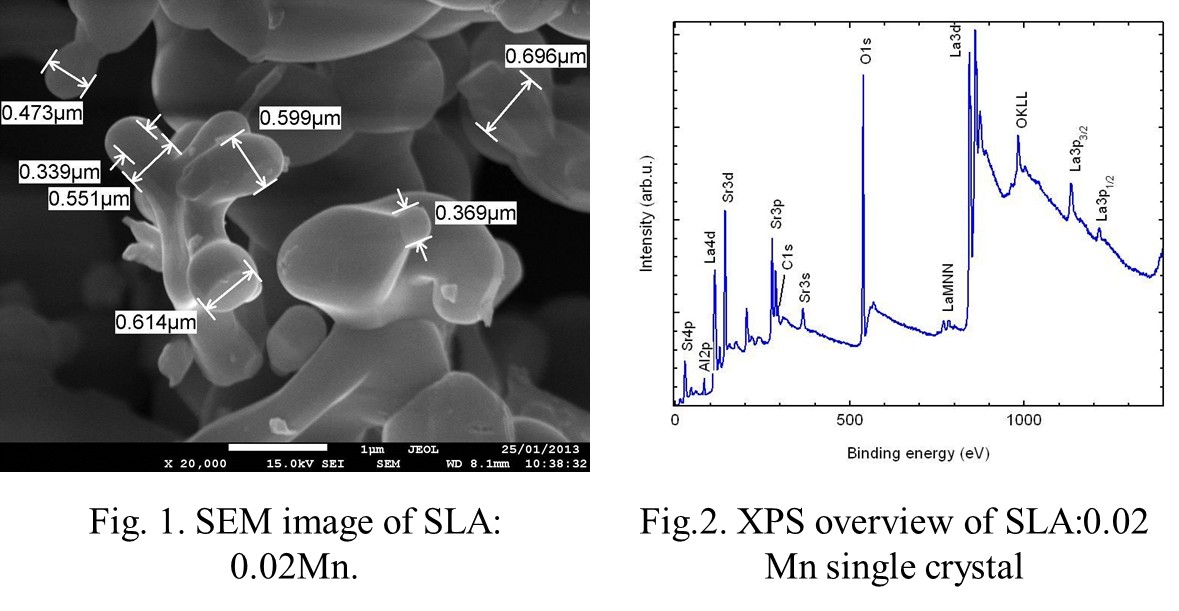| Search for content and authors |
Electronic structure and magnetic properties of nano and single crystals SrLaAlO4: Mn |
| Ewa Talik 1, Anna Pajaczkowska 2, Adam Guzik 1, Paweł Zajdel 1, Joachim Kusz 1, Agnieszka Szysiak 2 |
|
1. University of Silesia, Institute of Physics, Uniwersytecka 4, Katowice 40-007, Poland |
| Abstract | ||||||||||||||||||||
| SrLaAlO4 (SLA) compound belongs to the group of compounds with the chemical formula ABCO4, where A = Ca, Sr or Ba, B = Y or some other rare earth metal, and C = Al, Ga or some transition metal [1]. These compounds belong to the tetragonal K2NiF4 structure type with space group I4/mmm. Basic building elements of LaSrAlO4 structure are double planes of randomly distributed La/Sr ions in corrugated layers, placed between single flat square lattices of AlO2. These layered perovskite-related compounds have been intensively studied previously from the point of view of their possible applications as substrate material for high-temperature superconductors (HTSC) as well as host material for laser media and phosphors [1-4].
Single crystals of SrLaAlO4 doped by Mn ions were obtained by the Czochralski method. The crystals were grown from the nonstoichiometric melts of SrLa1,03Al0,97O4. This composition was reported earlier for obtaining of good quality SLA single crystal [1]. Thermal isolation of the system contains a ceramic disc between the crucible and the passive afterheater to ensure proper temperature gradient across the surface of the melt. Crystals were grown from iridium crucible of 50 mm in diameter. Crystal growth was conducted in pure nitrogen. Manganese dopant was introduced into the melt in the form of MnO2 oxide and was added to the above mentioned SLA compound. The assumed concentration of dopants in the melt was equal to 0, 02 and 0, 1 wt%. The pulling rate in the case of lower doping level was 1 mm/h and rotation rate was equal to 17 rpm. Good quality single crystals of 18 mm in diameter and 35 mm in length were grown using <100> seed orientated. Single crystals doped with 0.1 wt% of Mn were easily cracked, even when the pulling rate was reduced up to 0.7 mm/h. However, an inside some parts of crystal were good quality not cracked and were used in further investigations. SLA doped with Mn2+ ions (0,02 mol%) was synthesized by modified sol-gel (Pechini) method as follows: lanthanum oxide was dissolved in solution of acetic acid, then strontium carbonate, aluminum nitrate, solution of nitric acid and manganese acetate were added. After two hours of stirring the ethylene glycol as polymerizing agent was used. Subsequently the solvent was evaporated and the xerogel was dried at 150°C for 12 hours, grinded in an agate mortar to obtain fine powder, next annealed at 1450ºC in furnace for 4 hours. The diffraction patern shows the one phase compound of SLA structure. The purpose of the present work was to study electronic structure and magnetic properties of manganese ions in SrLaAlO4 host. Magnetic susceptibility was measured using a Quantum Design MPMS–XL–7AC SQUID magnetometer in the temperature range 1.9 – 400 K. The XPS spectra were obtained using a PHI 5700/660 Physical Electronics Photoelectron Spectrometer with monochromatized Al Kα X–ray radiation (1486.6 eV). The microstructural observations of the nanopowders as well as the microcompositional analysis were conducted on a JEOL–7600F scanning electron microscopy equipped with the Oxford X–ray energy dispersive spectroscope EDS. 
Table 1. Magnetic measurements results. Electronic structure measurements showed a decomposition of the surface of the nanocrystals SLA. Magnetic measurements confirmed the presence of Mn4+ in the measured doped samples what is essential for spectroscopic properties of such crystals.
Acknowledgements This work was partially financed by the Polish National Science Centre under grant no. NN 515 500 440. 1. A. Pajaczkowska, A. Gloubokov, Synthesis, growth and characterization of tetragonal ABCO4crystals, Prog. Crystal Growth and Charact. 36 (1998) 123–162. 2. W. Ryba-Romanowski, S. Gołąb, A. Gloubokov, A. Pajączkowska, Spectroscopic properties of chromium-doped SrLaAlO4 single crystals, Opt. Mater. 4 (1995) 515–519. 3. W. Ryba-Romanowski, S. Gołąb, I. Sokólska, W.A. Pisarski, G. Dominiak-Dzik, A. Pajączkowska, M. Berkowski, Anisotropy of optical properties of SrLaAlO4 and SrLaAlO4:Nd, J. Alloys Comp. 217 (1995) 263–267. 4. L. Vasylechko, N. Kodama, A. Matkovskii, Ya. Zhydachevskii, Crystal structure and optical spectroscopy of CaGdAlO4:Er single crystal, J. Alloys Comp.300-301 (2000) 475–478. 5. Ya. Zhydachevskii, A. Suchocki, D. Sugak, A. Luchechko, M. Berkowski, S. Warchol, R. Jakiela, Optical observation of the recharging processes of manganese ions in YAlO3:Mn crystals under radiation and thermal treatments. J. Phys.: Condens. Matter 18 (2006) 5389–5403. 6. Ya. Zhydachevskii A. Suchocki, M. Berkowski, D. Sugak, A. Luchechko, S. Warchol, Technological approaches for improving thermoluminescent properties of the Czochralski-grownYAlO3:Mn crystals. J.Cryst.Growth 310(2008) 3219–3232. | ||||||||||||||||||||
| Legal notice |
|
| Related papers |
Presentation: Poster at 17th International Conference on Crystal Growth and Epitaxy - ICCGE-17, Topical Session 6, by Ewa TalikSee On-line Journal of 17th International Conference on Crystal Growth and Epitaxy - ICCGE-17 Submitted: 2013-03-27 13:38 Revised: 2013-07-26 12:41 |